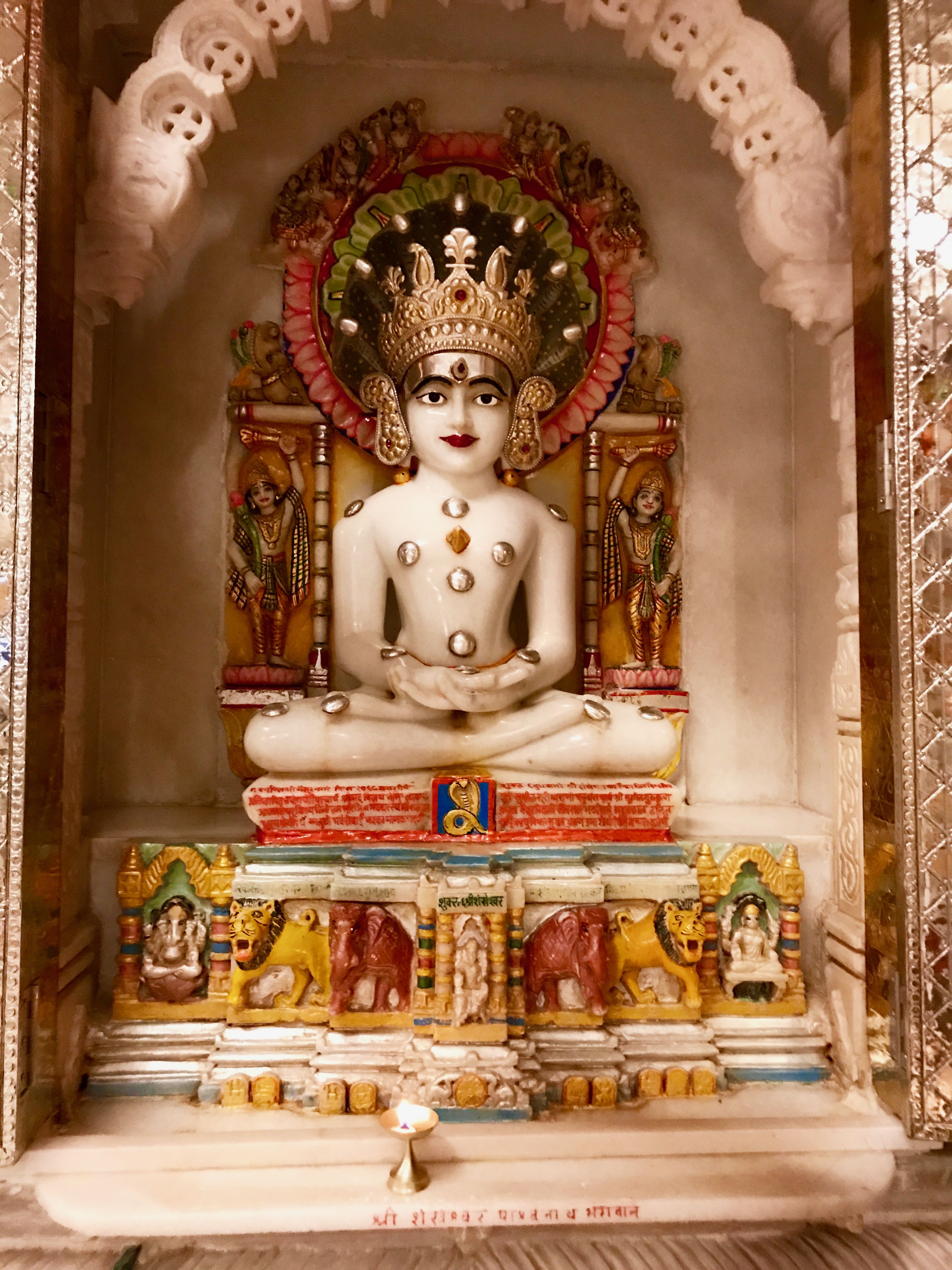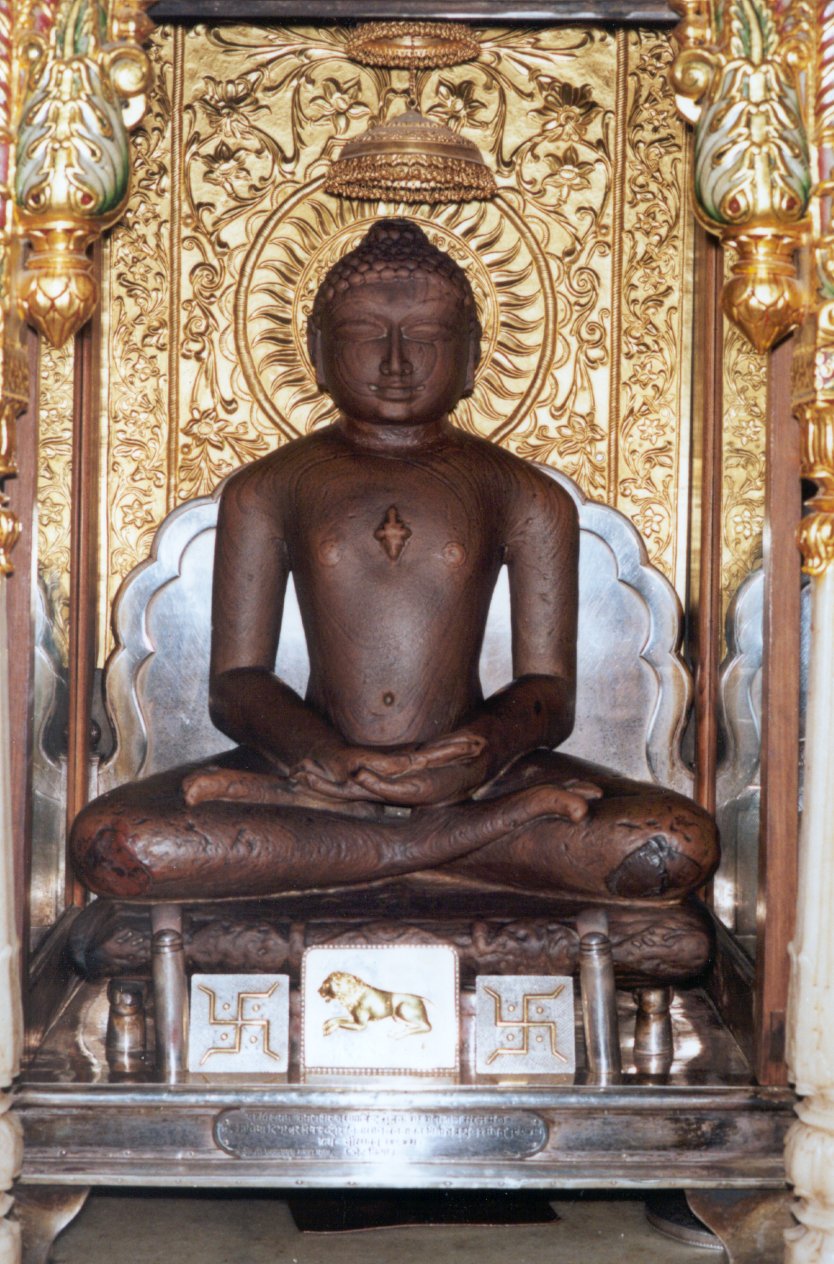|
Dṛṣṭivāda
The Dṛṣṭivāda or Drishtivaad ("Disputation about views") is a lost text in the Jain religion. It is the last of the 12 Jain āgamas as per Śvetámbara tradition, said to be promulgated by Māhavīra himself and composed by Ganadhara Sudharmaswami. The text is traditionally said to contain the entire knowledge of the Fourteen Purvas. However, its contents have been referred and explained in Nandi and ''Samavāyānga Sūtra''. Subdivisions The Dristivāda was divided into five parts, according to the ''Sarvārthasiddhi'' commentary from the Digambara tradition. #Parikarma, containing Jaina calculatory science #Sūtra, containing discussion about creeds and narratives #Prathamānuyoga (Pūrvanayoga), containing Puranic narratives, religious biographies, and illustrative tales # Pūrvagata, with fourteen subdivisions, containing discussions about Jaina doctrines and principles and may have been composed before the time of Mahavira #Cūlikā, containing the Purvas, kn ... [...More Info...] [...Related Items...] OR: [Wikipedia] [Google] [Baidu] |
Jain Texts
Jain literature () refers to the literature of the Jainism, Jain religion. It is a vast and ancient literary tradition, which was initially transmitted orally. The oldest surviving material is contained in the canonical ''Jain Agamas'', which are written in Ardhamagadhi Prakrit, Ardhamagadhi, a Prakrit (Middle Indo-Aryan languages, Middle-Indo Aryan) language. Various commentaries were written on these canonical texts by later Jain monasticism, Jain monks. Later works were also written in other languages, like Sanskrit and Maharashtri Prakrit. Jain literature is primarily divided between the canons of the ''Digambara'' and ''Śvētāmbara'' orders. These two main sects of Jainism do not always agree on which texts should be considered authoritative. More recent Jain literature has also been written in other languages, like Marathi language, Marathi, Tamil language, Tamil, Rajasthani language, Rajasthani, Dhundari language, Dhundari, Marwari language, Marwari, Hindi language, ... [...More Info...] [...Related Items...] OR: [Wikipedia] [Google] [Baidu] |
Jain Literature
Jain literature () refers to the literature of the Jain religion. It is a vast and ancient literary tradition, which was initially transmitted orally. The oldest surviving material is contained in the canonical ''Jain Agamas'', which are written in Ardhamagadhi, a Prakrit ( Middle-Indo Aryan) language. Various commentaries were written on these canonical texts by later Jain monks. Later works were also written in other languages, like Sanskrit and Maharashtri Prakrit. Jain literature is primarily divided between the canons of the ''Digambara'' and '' Śvētāmbara'' orders. These two main sects of Jainism do not always agree on which texts should be considered authoritative. More recent Jain literature has also been written in other languages, like Marathi, Tamil, Rajasthani, Dhundari, Marwari, Hindi, Gujarati, Kannada, Malayalam and more recently in English. Beliefs Jains believe their religion is eternal, and the teachings of the first tīrthaṅkara, Ṛṣa ... [...More Info...] [...Related Items...] OR: [Wikipedia] [Google] [Baidu] |
Jainism
Jainism ( ), also known as Jain Dharma, is an Indian religions, Indian religion whose three main pillars are nonviolence (), asceticism (), and a rejection of all simplistic and one-sided views of truth and reality (). Jainism traces its spiritual ideas and history through the succession of twenty-four , supreme preachers of ''dharma''. The first in the current time cycle is Rishabhadeva, who tradition holds lived millions of years ago; the 23rd is Parshvanatha, traditionally dated to the 9th century Common Era, BCE; and the 24th is Mahāvīra, Mahavira, who lived . Jainism is considered an eternal ''dharma'' with the guiding every time cycle of the Jain cosmology, cosmology. Central to understanding Jain philosophy is the concept of ''bhedavijñāna'', or the clear distinction in the nature of the soul and non-soul entities. This principle underscores the innate purity and potential for liberation within every Jīva (Jainism), soul, distinct from the physical and menta ... [...More Info...] [...Related Items...] OR: [Wikipedia] [Google] [Baidu] |
Śvetāmbara
The Śvetāmbara (; also spelled Shwetambara, Shvetambara, Svetambara or Swetambara) is one of the two main branches of Jainism, the other being the Digambara. ''Śvetāmbara'' in Sanskrit means "white-clad", and refers to its ascetics' practice of wearing white clothes, which sets it apart from the ''Digambara'' or "sky-clad" Jains whose ascetic practitioners go nude. Śvetāmbaras do not believe that ascetics must practice nudity. The Śvetāmbara and Digambara traditions have had historical differences ranging from their dress code, their temples and iconography, attitude towards Jain nuns, their legends and the texts they consider as important. Śvetāmbara Jain communities are currently found mainly in Gujarat, Rajasthan and coastal regions of Maharashtra. According to Jeffery D. Long, a scholar of Hindu and Jain studies, about four-fifths of all Jains in India are Śvetāmbaras. History and lineage Śvetāmbaras consider themselves to be the original followers of Maha ... [...More Info...] [...Related Items...] OR: [Wikipedia] [Google] [Baidu] |
Mahavira
Mahavira (Devanagari: महावीर, ), also known as Vardhamana (Devanagari: वर्धमान, ), was the 24th ''Tirthankara'' (Supreme Preacher and Ford Maker) of Jainism. Although the dates and most historical details of his life are uncertain and varies by sect, historians generally consider that he lived during the 6th or 5th century BCE, reviving and reforming a proto-Jain community (which had possibly been founded by Pārśvanātha), and that he was an older contemporary of Gautama Buddha. Jains regard him as the spiritual successor of the 23rd ''Tirthankara'' Parshvanatha. According to traditional legends and hagiographies, Mahavira was born in the early 6th century BCE to a royal Kshatriya Jain family of ancient India. His mother's name was Trishala and his father's name was Siddhartha. According to the second chapter of the Śvētāmbara Ācārāṅga Sūtra, Siddhartha and his family were devotees of Parshvanatha. Mahavira abandoned all worldly p ... [...More Info...] [...Related Items...] OR: [Wikipedia] [Google] [Baidu] |
Ganadhara
In Jainism, the term Ganadhara is used to refer the chief disciple of a ''Tirthankara''. In '' samavasarana'', the ''Tīrthankara'' sat on a throne without touching it (about two inches above it). Around, the ''Tīrthankara'' sits the ''Ganadharas''. According to Digambara tradition, only a disciple of exceptional brilliance and accomplishment (''riddhi'') is able to fully assimilate, without doubt, delusion, or misapprehension, the '' anekanta'' teachings of a ''Tirthankara''. The presence of such a disciple is mandatory in the ''samavasarana'' before ''Tirthankara'' delivers his sermons. ''Ganadhara'' interpret and mediate to other people the divine sound (''divyadhwani'') which the Jains claim emanates from Tirthankara's body when he preaches. The monastic sangha Sangha or saṃgha () is a term meaning "association", "assembly", "company" or "community". In a political context, it was historically used to denote a governing assembly in a republic or a kingdom, and ... [...More Info...] [...Related Items...] OR: [Wikipedia] [Google] [Baidu] |
Sudharmaswami
Sudharmaswami ( or Sudharman; 607 BC – 507 BC) was the fifth ganadhara of Mahavira. All the current Jain acharyas and monks follow his rule. Life Sudharmaswami was the spiritual successor of Indrabhuti Gautama in religious order reorganised by Mahavira. He is traditionally dated from 607 to 507 BC. In the Jain tradition he is believed to have obtained omniscience after 12 years in 515 BC. He is believed to have attained nirvana in 507 BC at the age of 100. The leadership of religious order was then transferred to Jambuswami who served for 44 years and was the last Ganadhara who survived after the death of Mahavira. For Jains, their scriptures represent the literal words of Mahavira and the other tirthankaras only to the extent that the agama texts are a series of fixed truths without a beginning or an end, and a tradition without any origin, human or divine, which in this world age has been channelled through Sudharmasvāmī. See also * Devardhigani Kshamashraman *Hemac ... [...More Info...] [...Related Items...] OR: [Wikipedia] [Google] [Baidu] |
Purvas
The Fourteen Purvas (meaning ancient or prior knowledge) are a large body of Jain scriptures that was preached by all Tirthankaras (omniscient teachers) of Jainism encompassing the entire gamut of knowledge available in this universe. The persons having the knowledge of purvas were given an exalted status of ''Shrutakevali'' or "scripturally omniscient persons". Both the Jain traditions, Śvetāmbara and Digambara hold that all the fourteen purvas have been lost.Jaini, Padmanabh (1998). ''The Jaina Path of Purification''. New Delhi: Motilal Banarsidass. . According to tradition, the Purvas were part of canonical literature and deposited in the third section of Drstivada (the twelfth and last canon). Knowledge of Purvas became fairly vulnerable after Mahavira's nirvana (liberation) and on account of effects of famine, such that, eventually only one person— Bhadrabahu Svami had a command over it. In accordance with the prophecy of Mahavira, the knowledge of Purvas died within 1,0 ... [...More Info...] [...Related Items...] OR: [Wikipedia] [Google] [Baidu] |
Sarvārthasiddhi
''Sarvārthasiddhi'' is a famous Jain text authored by Acharya (Jainism), Ācārya Pujyapada. It is the oldest extant commentary on ''Ācārya Umaswami's Tattvartha Sutra, Tattvārthasūtra'' (another famous Jain text). Traditionally though, the oldest commentary on the Tattvārthasūtra is the Gandhahastimahābhāṣya. A commentary is a word-by-word or line-by-line explication of a text. Author ''Acharya (Jainism), Ācārya Pujyapada'', the author of ''Sarvārthasiddhi'' was a famous Digambara monk. ''Pujyapada'' was a poet, grammarian, philosopher and a profound scholar of ''Ayurveda''. Content The author begins with an explanation of the invocation of the ''Tattvārthasūtra''. The ten chapters of ''Sarvārthasiddhi'' are: #Faith and Knowledge #The Category of the Living #The Lower World and the Middle World #The Celestial Beings #The Category of the Non-Living #Influx of Karma #The Five Vows #Bondage of Karma #Stoppage and Shedding of Karma #Liberation In the text, ' ... [...More Info...] [...Related Items...] OR: [Wikipedia] [Google] [Baidu] |
Digambara
''Digambara'' (; "sky-clad") is one of the two major Jain schools and branches, schools of Jainism, the other being ''Śvetāmbara'' (white-clad). The Sanskrit word ''Digambara'' means "sky-clad", referring to their traditional monastic practice of neither possessing nor wearing any clothes. Nakedness was the ideal practice of lord Mahavira and his immediate followers. Mahavira emphasized the importance of nakedness for monks. It symbolizes complete detachment and is an ideal form of conduct. Mahavira believed that renouncing clothes made the body immune to external influences like heat and cold, increasing resilience. Without clothes, a monk would avoid the distractions of acquiring, maintaining, and washing garments, allowing him to focus on spiritual growth and self-discipline. Digambara and Śvetāmbara traditions have had historical differences ranging from their dress code, their temples and iconography, attitude towards female monastics, their legends, and the texts the ... [...More Info...] [...Related Items...] OR: [Wikipedia] [Google] [Baidu] |
Pūrvagata
The Fourteen Purvas (meaning ancient or prior knowledge) are a large body of Jain scriptures that was preached by all Tirthankaras (omniscient teachers) of Jainism encompassing the entire gamut of knowledge available in this universe. The persons having the knowledge of purvas were given an exalted status of ''Shrutakevali'' or "scripturally omniscient persons". Both the Jain traditions, Śvetāmbara and Digambara hold that all the fourteen purvas have been lost.Jaini, Padmanabh (1998). ''The Jaina Path of Purification''. New Delhi: Motilal Banarsidass. . According to tradition, the Purvas were part of canonical literature and deposited in the third section of Drstivada (the twelfth and last canon). Knowledge of Purvas became fairly vulnerable after Mahavira's nirvana (liberation) and on account of effects of famine, such that, eventually only one person— Bhadrabahu Svami had a command over it. In accordance with the prophecy of Mahavira, the knowledge of Purvas died within 1,00 ... [...More Info...] [...Related Items...] OR: [Wikipedia] [Google] [Baidu] |




